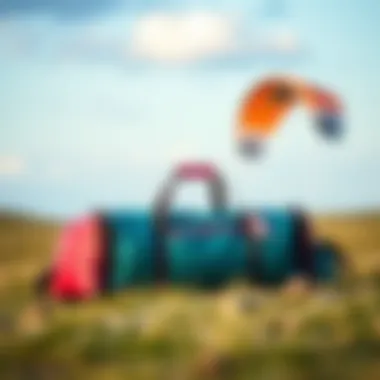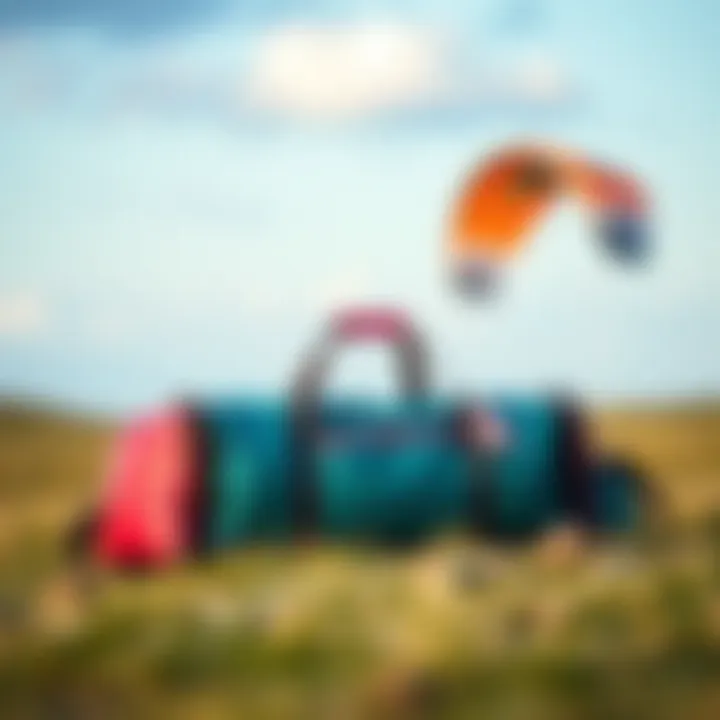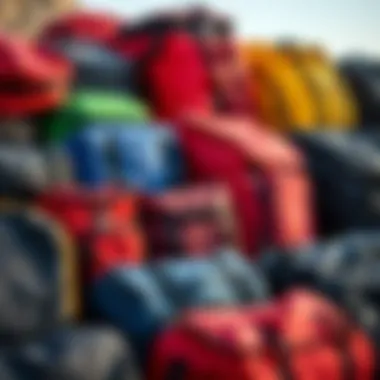The Complete Guide to Kite Travel Bags for Enthusiasts


Intro
Kiteboarding is more than just a sport; it's a lifestyle that blends adventure, freedom, and connection to nature. Among the many considerations for those who embrace this hobby, having the right gear to travel with your kite is paramount. A dedicated travel bag specifically designed for kites not only protects your equipment but also facilitates easier transport, ensuring that when you reach your destination, you're ready to ride the waves or glide across the flats without a hitch.
When you're jetting off to the next wind-rich paradise, the bag you choose can make all the difference. In this guide, we’ll dissect the various types of kite travel bags available, dive into important features to watch for, and discuss materials suited for kite protection. Additionally, we’ll provide maintenance tips to keep your bag in top condition, as well as insights on how to select the right one based on your specific travel needs. Through this deep dive, you’ll walk away with a robust understanding of kite travel accessories and how they can enhance your kiteboarding experiences.
Prolusion to Kite Travel Bags
Kite travel bags hold a crucial place in the world of kiteboarding, serving as the protective shells for the expensive and delicate gear that enthusiasts often carry along. This brief introduction aims to explore why these bags are indispensable for any kiteboarder looking to maintain their equipment and enhance their overall travel experience.
First off, it's important to recognize that kite gear, while exhilarating to use, can be quite sensitive to environmental conditions. Wind, saltwater, and impacts of travel can all take a serious toll. Here’s where kite travel bags come into play. They are designed not just for carrying kites, but for shielding them from the elements and the potential mishaps that come with journeys.
When you choose a quality kite travel bag, you’re investing in protection. These bags often incorporate durable materials that are resistant to wear and tear. Many also feature padded sections to safeguard the kite’s delicate fabric and accessories like bars and lines. Imagine arriving at your destination and realizing your favorite kite has taken a hit in transit! It’s a nightmare scenario that can be easily avoided.
Consideration Matters
Choosing the right kite travel bag isn’t just about protection; it also has a significant impact on convenience. A well-designed bag should accommodate all the necessary gear in a manageable way. Size and capacity can vary, so evaluating what fits your specific needs is important. You don’t want to be hauling around a cumbersome bag when a more streamlined option would do the trick.
Moreover, a kite travel bag should not merely be about functionality; it should offer ease of use. Features such as multiple carry straps or wheels can make the difference between a smooth experience and one riddled with frustration.
Importance of a Kite Travel Bag
When it comes to kiteboarding, enthusiasts know that proper equipment is paramount. However, an often-overlooked component of the gear is the kite travel bag. A quality travel bag is more than just a container; it serves as a guardian for your precious kites and accessories, ensuring they stay safe and intact through various journeys. In this section, we will discuss two crucial aspects: protection of gear and convenience during travel.
Protection of Gear
Imagine preparing for a kiteboarding trip, excitement buzzing in your veins, only to find your kite damaged due to improper storage and transportation. A well-designed kite travel bag is essential for protecting your gear against the elements and impacts during transit. Given the nature of kiteboards, which are crafted with delicate materials and components, a resilient bag can make a world of difference.
- Durability of Materials: Quality travel bags are often constructed from tough, durable fabrics that resist wear and tear. Materials like 1680D nylon or polyvinyl chloride (PVC) are typical choices that provide extra durability while keeping the bag relatively lightweight.
- Padding and Cushioning: Adequate padding is crucial. Look for bags that include specialized compartments for kites, boards, and harnesses. This way, each piece of equipment is held securely in place, minimizing movement and potential damage.
"A good kite travel bag is like a seatbelt for your gear; it keeps everything safe and secure during the bumps along the journey."
Convenience During Travel
Traveling with kite gear can often feel like carrying a small house on your back. However, the right kite travel bag can significantly lighten the load when it comes to organization and accessibility.
- Smart Design and Organization: Many bags come equipped with various pockets, compartments, and even external straps allowing for easy access to your most-used items. This means no more digging through your bag trying to fish out your harness or rash guard. You can have everything neatly organized and at your fingertips.
- Ease of Carrying: Comfort is key during any voyage. A good travel bag should come with padded handles and shoulder straps, making it easier to lug around airports, beaches, or any travel hub. Some bags even offer wheels and retractable handles for effortless transport.
As kiteboarders often trek to remote locations, having a convenient travel bag can mean the difference between a stress-free trip and a frustrating ordeal. The right bag helps keep the focus on the adventure rather than on logistics.
In summary, the importance of a kite travel bag cannot be overstated. It not only protects your valuable gear but also enhances your overall travel experience. Thus, investing in a quality travel bag should be a priority for any kiteboarding enthusiast.
Types of Kite Travel Bags
When it comes to kitesurfing, having the right gear is paramount, but selecting a suitable travel bag for your equipment can be just as vital. Different types of kite travel bags cater to varying needs and preferences. Understanding these options helps kiteboarders make informed decisions tailored to their travel habits, gear choices, and the unique challenges their adventures may present.
Hard Cases
Hard cases are like the armored trucks of kite travel. They offer exceptional protection for your gear, making them ideal for international travel or when gear could face rough handling. These cases are typically made from sturdy materials like polycarbonate or ABS plastic, which absorb shock and resist impact.
- Pros:
- Cons:
- Unmatched durability and protection
- Security against moisture and dust
- Often come with customizable foam interiors to fit your equipment snugly.
- Heavier and bulkier than other bags
- More expensive due to the robust materials
Ideal for serious kiteboarders, hard cases provide peace of mind, especially when trusting your equipment to airline baggage handlers. They may be overkill for casual day trips but shine on long journeys where gear safety is a priority.
Soft Bags
Soft bags are a popular and user-friendly option among kiteboarders. Made from lighter materials like nylon or polyester, they provide flexibility and ease of transport without compromising too much on protection.
- Pros:
- Cons:


- Lightweight and easier to carry
- Often more affordable than hard cases
- Available in various sizes to accommodate specific gear configurations
- Less impact protection compared to hard cases
- Not fully weatherproof; exposure to rain could damage your gear
For those who travel frequently on shorter trips or in mild climates, soft bags may be the perfect blend of convenience and functionality. They can also be stowed away more easily when not in use, making them a go-to choice for many kiteboarders.
Backpacks
Backpacks, designed specifically for kitesurfers, have been gaining traction in recent years. These bags are about combining the best of portability and capacity. Often featuring organized compartments for separate pieces of gear, they allow for hands-free travel and ease of movement.
- Pros:
- Cons:
- Excellent for day trips or local visits
- More compact for easy transportation
- Comfortable to carry over long distances
- Limited protection against impact
- Might not fit larger three- or four-line kites and all accessories
Backpacks provide kiteboarders with versatility, especially when heading out to less accessible locations. They allow for quick access to essentials and are perfect for those who value convenience in mobility.
In summary, each type of kite travel bag has its unique pros and cons. Your choice should reflect your travel style, the fragility of your gear, and how you like to move around. In the next section, we'll delve into key features to consider when selecting your kite travel bag.
Key Features to Consider
When diving into the world of kite travel bags, taking note of certain features can make a world of difference in your travels. Having a good understanding of these key elements ensures that you choose a bag that meets your needs while keeping your equipment secure and accessible. It’s not just about picking any bag from the shelf; it’s about finding one that keeps your gear safe while also being user-friendly.
Materials Used
The materials your kite travel bag is made from play a crucial role in its durability, weight, and overall performance. High-quality bags often utilize fabrics like nylon or polyester, which provide a great balance of weight and strength. These materials resist wear and tear while keeping the bag lightweight, enabling you to travel without constantly worrying about the weight restrictions that airlines impose. For a bit of extra protection during rough handling, look for bags with reinforced seams or water-resistant coatings.
Here are some common types of materials found in kite travel bags:
- Nylon: Strong and lightweight; often water-resistant.
- Polyester: Good durability and color retention, although typically heavier than nylon.
- Ripstop fabric: This material is designed to prevent rips and tears from spreading, adding long-term value.
Each of these materials comes with its pros and cons, so weigh them against your specific travel and usage conditions. Seasonal shifts in weather should steer your choice, as some materials handle moisture and elements better than others.
Size and Capacity
Size matters, particularly when it comes to kite bags. The dimensions should not only accommodate your gear but also align with your mode of transportation. Traveling by plane? Think about the dimensions allowed by airlines, as well as how much gear you want to pack.
Kite travel bags come in various sizes:
- Small bags: Suitable for one kite and limited equipment, often favored for short trips.
- Medium bags: Perfect for an intermediate amount of gear, allowing for a couple of kites, bars, and accessories.
- Large bags: Designed for those who bring the kitchen sink, accommodating multiple kites, wetsuits, and other gear.
While opting for a larger bag may seem enticing, it’s essential to remember that a heavier bag can cause more strain during transit. Seek a balance; a bag that’s too big might lead to overpacking, whereas a snug size might leave you scrambling to fit gear on the move.
Strap and Handle Design
Ergonomics matter when it comes to the comfort of carrying your kite travel bag. The right strap and handle design can transform a cumbersome task into something manageable.
Consider the following:
- Shoulder straps: Padded and adjustable straps are crucial for distributing weight evenly and ensuring comfort over prolonged periods.
- Top and side handles: These should be sturdy enough to withstand vigorous use. A bag with multiple handles allows flexible carrying options in different environments, whether you’re hoisting it into a car or dragging it through an airport.
- Backpack style: Some modern bags come with backpack-style straps, providing hands-free convenience. This can be a life-saver when you're navigating busy spaces like ticket queues or public transport.
Ultimately, selecting a bag that offers supportive straps and handles will minimize fatigue, making your kiteboarding excursions far more enjoyable. A little attention to these details can prevent sore shoulders and back pains, enabling you to enjoy a hassle-free trip.
Best Practices for Packing a Kite Travel Bag
Packing a kite travel bag might seem a straightforward task, but there’s a certain science to it that can drastically affect your gear's safety, functionality, and your overall travel experience. Understanding best practices ensures that everything fits snugly without excessive movement, minimizing wear and tear over time. It also allows you to maximize space—because let’s face it, no one wants to fuss with a bulging bag when rushing to catch a flight. Let's dive into some specific practices that will help you pack like a pro.
Layering Techniques
Layering your equipment is akin to building a cake; the way you stack your items can make all the difference. Placing heavier items at the bottom not only provides a stable foundation but also prevents damage to lighter gear on top. For instance, start with your kite, laid flat and folded correctly. Next, consider placing your board above it, followed by harnesses and other smaller items. Each layer should contribute to the overall balance of the bag.
To enhance protection, consider using a soft cloth or bubble wrap between layers. This strategy will cushion more fragile components, fostering a safe environment throughout your journey.


Utilizing Space Effectively
Every inch counts when it comes to packing a kite travel bag. Utilizing space effectively means being strategic about how you place items. Roll your clothes or use compression bags for any textiles, squeezing out excess air. This can free up space for additional gear or clothes. You can also stuff smaller items—like foot straps or wetsuits—inside your board, making sure all nooks and crannies are put to good use.
Another tip is to use packing cubes or mesh bags to keep things organized. This not only helps in finding what you need quickly but also keeps everything neatly compartmentalized. The objective is to prevent unnecessary jostling, as that can cause wear on your gear or even break delicate parts.
Protecting Fragile Components
Kite gear is known for its resilience, but there are always components that need a bit more TLC. Items such as bladders, lines, or any electronic devices should be treated with utmost care. Placing these fragile components in padded sections of your bag or wrapping them in extra clothing can provide an added layer of protection against impacts.
Remember, prevention is better than cure. A ripped kite or damaged board can spoil the thrill of kiteboarding, so it’s essential to think ahead.
For instance, if you’re traveling with your kite's inflatable bladders, ensure they're deflated properly to avoid any unnecessary pressure damage. Doing so can also save space, making packing a whole lot easier.
Using these packing strategies will not only keep your gear secure but will also streamline your travel process. Adopting these best practices ensures your kite travels just as smoothly as you do, keeping everything safe and sound for your next adventure.
Maintenance Tips for Kite Travel Bags
Keeping your kite travel bag in tip-top shape is crucial for ensuring that your gear remains protected during those long trips to the beach or kite festival. Maintaining your bag not only extends its lifespan but also enhances the overall kiteboarding experience. After all, a well-maintained bag can save you from unexpected surprises when you're caught between a beautiful kiteboarding day and a ruined trip due to damaged gear.
A little effort goes a long way. Let’s dive into some essential maintenance tips, focusing on how you can clean and care for your bag, as well as the best storage practices.
Cleaning and Care
When it comes to maintaining a kite travel bag, regular cleaning is non-negotiable. Sand, saltwater, and dust can find their way into every nook and cranny, leading not only to wear and tear but also to unpleasant odors. Here’s how you can keep it fresh:
- Spot Cleaning: For stubborn stains, use a mild soap mixed with water. A soft-bristle brush works wonders for scrubbing those challenging spots without damaging the material.
- Rinse After Use: Whenever you finish a session, take a moment to shake out any sand and rinse your bag with fresh water. This action reduces the buildup of salt and grime.
- Drying: Always let your bag dry completely before storing it away. Most materials are prone to mildew, and damp bags can harbor foul smells and bacteria.
"Treat your gear like you treat your friends; they go through a lot together, and a little care can keep it intact!"
By implementing these simple cleaning methods, you’ll not only keep your bag looking good but also functioning properly.
Storage Recommendations
Storing your kite travel bag properly is just as important as cleaning it. The wrong storage conditions can lead to deformations and deterioration of the materials, making your bag a liability rather than an asset. Here are some key pointers for effective storage:
- Dry and Cool Environment: Aim for a dry place away from direct sunlight. UV rays can break down the material and colors over time.
- Avoid Tight Spaces: Don’t cram your bag with too much stuff or store it in a cramped space. This can lead to creases and structural damage.
- Keep It Upright or Flat: Depending on the design, store the bag upright or flat to maintain its shape. If it has rigid parts, be particularly careful with how you position it.
- Air It Out: On occasion, allow your bag to breathe by taking it out and hanging it somewhere airy. This helps mitigate any odors and keeps the materials flexible.
By following these storage tips, you can rest assured that your kite travel bag is in good hands, ready for the next adventure whenever you are. Proper maintenance isn’t just about keeping things clean; it’s about preserving your investment and ensuring that your gardening allows you to focus on more important things – like catching those epic waves.
Selecting the Right Kite Travel Bag
Choosing the correct kite travel bag is crucial for any kiteboarding enthusiast. The right bag not only safeguards your equipment but also enhances your overall travel experience. Given the numerous options available, making an informed decision can often feel like finding a needle in a haystack.
First, you should assess how often you travel. This factor significantly influences not just the type of bag, but also its durability and features. Frequent flyers might lean toward a robust hard case that can weather the rigors of constant transportation. On the other hand, if you’re just going for the occasional getaway, a soft bag or a backpack might suffice, providing a good balance between protection and portability.
Assessing Travel Frequency
When considering your kite travel bag, understanding your travel frequency is one of the starting points. Here are some elements to consider:
- Regular Travelers: If you're the type to find yourself at the beach nearly every weekend, consider investing in a hard case that can endure frequent handling. This type of bag offers maximum protection against drops and rough handling at airports.
- Occasional Adventurers: For those who only hit the waves a couple of times a year, a well-padded soft bag might be the way to go. These bags provide lightweight convenience without excessively stressing your wallet.
Travel frequency affects not just the construction of the bag but also its weight and overall size. A bag that’s too large can be cumbersome, while one that’s too small might leave you scrambling for space.
Considering Your Kite Size and Number
Another important consideration in selecting the right kite travel bag is the overall size and number of kites you plan to carry. Will you be traveling with a single setup or multiple kites? Here are some aspects to ponder:
- Multiple Kites: If you often take different types of kites based on weather conditions, opt for a larger bag with multiple compartments or designated areas for each kite. This keeps your setup organized and prevents potential damage during transit.
- Single Kite: If it’s just you and your favorite kite, ensure the bag fits snugly without excess space. Too much wiggle room means increased risk of friction damage, especially during bumps along the journey.
Make sure to consider additional space for other gear such as harnesses, lines, and boards. Prior planning can save headaches later on.
Budget Considerations


Lastly, it’s imperative to evaluate your budget when selecting a kite travel bag. The market spans a wide range of prices and qualities:
- High-End Options: Some premium brands, like Dakine and North Kiteboarding, offer bags engineered for durability and protection but can come at a pricey tag. If you have the budget, it's a worthwhile investment.
- Mid-Range Selection: For those who want a balance of quality and affordability, brands like Mystic and Prolimit often provide solid options that don't break the bank.
- Budget-Friendly Choices: There are also less expensive options. However, do your research; not all budget brands offer the right level of protection, so opt for popular models that have positive reviews.
Choosing the right kite travel bag boils down to your unique needs and preferences. With the right bag in hand, you’ll be ready to hit the kiteboarding scene without a worry in the world.
Popular Brands and Models
When it comes to selecting a kite travel bag, the brands that produce them play a key role in equipping kiteboarders with reliable options. The relevance of this section lies in guiding users through an array of well-known brands and distinguishing features that help them make informed decisions. Popular brands do not only offer various styles and sizes of bags but often stand behind their products with effective customer support, ensuring that you get not just a bag, but a quality investment for years to come.
A valid question arises: why does brand matter? Often, popular brands come with assurances of quality and durability, not only through their manufacturing processes but also by paying attention to user feedback, thus continuously improving their products. These bags are designed to withstand the rigors of travel, protecting your kite gear as you navigate your adventurous lifestyle.
Brand Overview
Several key brands have carved a niche for themselves in the market of kite travel bags. Let's take a look at some of the most notable ones:
- Dakine: Known for its functional designs, Dakine offers a range of kite travel bags that cater to different needs—ranging from lightweight options to extensive protection for long-distance trips. The materials are often weather-resistant, keeping your gear safe from unpredictable elements.
- Prolimit: This brand is well-regarded for producing durable and practical kite bags. They focus on user convenience and tend to provide extras, such as pockets for harnesses and tools, allowing for organized packing.
- ION: ION bags often feature modern designs combined with practical solutions for travel. Their emphasis on comfort means users can carry them without straining themselves, even over long distances.
- Ozone: As a trusted name in the kiteboarding community, Ozone packs in quality and performance with their travel bags. They ensure their bags protect your gear while remaining fashionable and sleek.
Understanding these brands can provide insights into which options may align best with your personal style and travel needs.
Feature Comparisons
When digging deeper into kite travel bags, focusing on the features these brands incorporate helps shed light on their individual advantages:
- Material Quality: Many brands use high-denier nylon or polyester for durability. While Dakine might lean towards a more versatile, lightweight fabric, Prolimit often incorporates waterproof elements to withstand harsher conditions.
- Size Variability: The size of the bags can vary significantly, impacting how much gear you can take along. ION’s bags are often spacious yet cleverly designed to avoid bulkiness.
- Organization: Look at the internal design. Ozone tends to prioritize organizational pockets, while Dakine provides an overall simpler layout that may appeal to those who prefer minimalism.
- Weight: Weight can become a crucial factor, especially when traveling with airlines that impose strict baggage limits. Prolimit’s lightweight variants enable users to carry more without reaching weight thresholds.
Comparing these features can help you narrow down the bag that best meets your travel and kiteboarding requirements.
"Choosing a kite travel bag is not just about protection, it's about enhancing your overall kiteboarding experience and ensuring your gear is ready to go when adventure calls."
For more information on what to consider when choosing your kite travel bag, you can explore resources such as Wikipedia, which offers insights into the history of kite sports. Or check out user reviews on Reddit to see what fellow kiteboarders are saying about their experiences with different products.
Traveling with a Kite Travel Bag
Traveling with a kite travel bag isn’t just about tossing your gear into a tote and hoping for the best. For kiteboarders and outdoor enthusiasts alike, knowing the ins and outs of traveling with your equipment can save you headaches down the line. Understanding the importance of well-planned travel procedures ensures your gear arrives at your destination in pristine condition and is ready to hit the waves.
Airport Procedures
Navigating airport procedures can feel like walking a tightrope when you’re hauling your kite gear. Here are the key points to keep in mind:
- Check Airline Policies: Different airlines have varied policies regarding oversized luggage. Before you book your ticket, hunt down the guidelines on their website, especially regarding kite boards and bags.
- Size and Weight Restrictions: Most airlines set a limit on how heavy and large your travel bag can be. Packing efficiently is essential. Consider using a soft bag that squeezes down if needed. Know your bag's dimensions and weight ahead of time to avoid unexpected fees.
- Arrive Early: Give yourself plenty of time at the airport. Longer wait times can occur at check-in when registering larger items. This isn’t the place to be in a rush—trust me on that one.
- Security Screening: Prepare for security checks as well. If you’re carrying multiple items, it may be necessary to remove certain pieces so they can get a clear look at your equipment. Boneless kites might be scrutinized, so stay calm and explain what’s inside.
- Domestic vs. International Flights: If you’re flying internationally, be very aware that regulations differ significantly. With that, you might require additional documentation or face customs checks that can delay your travels.
Managing these steps efficiently can make your travel smoother.
Customs Regulations
When crossing borders, customs regulations can cause some unwanted friction, especially if you’re unaware of what's required. Here are some considerations:
- Declare Your Equipment: Some countries require you to declare sports equipment when you arrive. Not declaring can trigger fines or confiscation.
- Know Import Restrictions: Certain countries have strict rules on foreign goods. Always check local customs regulations to avoid showing up with gear that can only be used at your own risk.
- Value Declarations: If your gear is of high value, be prepared to list its worth. Sometimes customs officers ask about expensive equipment for duty purposes. Have receipts available if necessary.
- Temporary Importation: For gear used temporarily, some countries have specific processes to follow. Understanding how to fill out these forms can save you a lot of heartache.
Travel is what feeds the soul, but when kiting is involved, navigating testy airport proceedings and quirky customs regulations is just part of the deal. By arming yourself with the right knowledge and gear, those restless tides of travel can transform into total tranquility.
Ending
In concluding this exploration into kite travel bags, we recognize their significance within the kiteboarding culture. A suitable kite travel bag can be more than just a vessel; it encapsulates a sense of security for your gear. The right bag ensures that equipment is shielded from the wear and tear of travel, enabling kiteboarders to focus on the thrill of their next adventure rather than fretting over potential damages.
When selecting a kite travel bag, several critical elements must be taken into account. You want to look for a bag that meets your unique travel habits. Frequent travelers might benefit from a durable hard case, offering unparalleled protection against rough handling, whereas occasional trip takers might find a soft bag more than sufficient.
The dimensions and design of the bag play crucial roles as well. Consider your kite size, number of boards, and additional gear when choosing a bag. Striking the balance between size and capacity is essential, as an oversized bag can be cumbersome and unwieldy while an undersized one may leave your equipment vulnerable.
Moreover, features like padded straps and easy-to-grab handles enhance user experience. These details might seem minor but can greatly impact your journey from one destination to another. Adaptability to varied travel modes—be it a bumpy road trip or a crowded airport—adds to the overall convenience.
Ultimately, embracing the knowledge around kite travel bags isn't merely a matter of practicality but also enriches the kiteboarding experience itself. With informed choices, kiteboarders can participate in the sport holistically, relishing each moment of travel as an extension of their passion.
In essence, this guide aims to empower enthusiasts with the tools they need to navigate the sea of options available, ensuring that they are well-equipped for all their kite adventures ahead.
"A kite travel bag is not just an accessory; it's the guardian of your adventures."
For more on gear care and travel tips, you may find resources useful at Britannica and Reddit.















